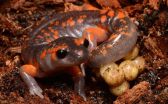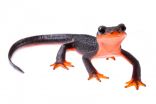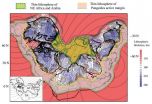North America's salamanders at risk of epidemic from overseas
2015-07-30
(Press-News.org) This news release is available in Japanese.
The international pet trade threatens to spread a deadly fungal infection to North America's rich wild salamander population and must be frozen, according to the authors of this Policy Forum. Batrachochytrium salamandrivorans (Bsal) is a highly virulent, often fatal fungus that infects salamanders, and there is no effective way to control it after it infects a wild population, say Tiffany Yap and colleagues. It is theorized that Bsal started in Asia and spread to wild European salamanders via the international pet trade, causing a mass die-off in the Netherlands and endangering North America, which is home to nearly half of all recognized salamander species. Yap and colleagues combined maps of Bsal's most suitable habitats in North America and areas with the greatest salamander biodiversity to create a predictive model of where wild salamanders are most vulnerable. They found three high-risk zones, and the five most-active U.S. ports are all within or near them. The authors call for an immediate ban on live salamander imports until protocols to stop the spread of Bsal are established. Immediate action by the U.S. is critical yet insufficient, they say. Either existing international organizations concerned with animal health must prioritize wildlife epidemics and be granted the necessary powers to intervene in the international pet trade, or a new organization must be founded.
INFORMATION:
Article #3: "Averting a North American biodiversity crisis," by T.A. Yap; R.F. Ambrose at University of California, Los Angeles in Los Angeles, CA; T.A. Yap; M.S. Koo; D.B. Wake; V.T. Vredenburg at University of California, Berkeley in Berkeley, CA; T.A. Yap; V.T. Vredenburg at San Francisco State University in San Francisco, CA.
ELSE PRESS RELEASES FROM THIS DATE:
2015-07-30
SAN FRANCISCO, CA - July 30, 2015 - A study released today at the Society of NeuroInterventional Surgery 12th Annual Meeting in San Francisco, California, indicates that strict adherence to two commonly-used tools to weigh the risk of treating unruptured aneurysms may not prevent the majority of morbidity-mortality outcomes associated with ruptured intracranial aneurysms. Thus, the International Study of Unruptured Intracranial Aneurysms (ISUIA) criteria and the PHASES score require additional research to determine their effectiveness.
Published in 2003, the ISUIA study ...
2015-07-30
Boston, MA -- New research from Harvard T.H. Chan School of Public Health describes a molecular mechanism that helps explain how obesity-related inflammation can lead to type 2 diabetes. The findings describe a surprising connection between two molecular processes that are known to be involved in the development of metabolic disease--inflammation and endoplasmic reticulum (ER) dysfunction--and suggest that targeting this connection could aid in the development of new therapies.
The study will be published in the July 31, 2015 issue of Science.
Specifically, the researchers ...
2015-07-30
Scientists have long worked to understand how crystals grow into complex shapes. Crystals are important in materials from skeletons and shells to soils and semiconductor materials, but much is unknown about how they form.
Now, an international group of researchers has shown how nature uses a variety of pathways to grow crystals that go beyond the classical, one-atom-at-a-time route.
The findings, published today (Thursday, July 30) in Science, have implications for decades-old questions in science and technology regarding how animals and plants grow minerals into shapes ...
2015-07-30
IgA deficiency is one of the most common genetic immunodeficiency disorders in humans and is associated with an insufficiency or complete absence of the antibody IgA. Researchers led from Uppsala University and Karolinska Institutet in Sweden have now performed the first comparative genetic study of IgA deficiency by using the dog as genetic disease model. Novel candidate genes have been identified and the results are published in PLOS ONE.
People with low IgA are at higher risk for developing recurrent infections, allergies and autoimmunity. The underlying genetic factors ...
2015-07-30
Highly active anti-retroviral therapy (HAART) has helped millions survive the human immunodeficiency virus (HIV). Unfortunately, HIV has a built-in survival mechanism, creating reservoirs of latent, inactive virus that are invisible to both HAART and the immune system.
But now, researchers at UC Davis have identified a compound that activates latent HIV, offering the tantalizing possibility that the virus can be flushed out of the silent reservoirs and fully cured. Even better, the compound (PEP005) is already approved by the FDA. The study was published in the journal ...
2015-07-30
(SEOUL and BOSTON) - The concept of walking on water might sound supernatural, but in fact it is a quite natural phenomenon. Many small living creatures leverage water's surface tension to maneuver themselves around. One of the most complex maneuvers, jumping on water, is achieved by a species of semi-aquatic insects called water striders that not only skim along water's surface but also generate enough upward thrust with their legs to launch themselves airborne from it.
Now, emulating this natural form of water-based locomotion, an international team of scientists from ...
2015-07-30
A study by researchers at the National Institute of Allergy and Infectious Diseases and Duke University helps explain why the candidate vaccine used in the HVTN 505 clinical trial was not protective against HIV infection despite robustly inducing anti-HIV antibodies: the vaccine stimulated antibodies that recognized HIV as well as microbes commonly found in the intestinal tract, part of the body's microbiome. The researchers suggest that these antibodies arose because the vaccine boosted an existing antibody response to the intestinal microbiome, which may explain why ...
2015-07-30
Washington -- Thousands of nonhuman primates continue to be confined alone in laboratories despite 30-year-old federal regulations and guidelines mandating that social housing of primates should be the default. A new article co-authored by PETA scientists and Marymount University researchers, published in Perspectives in Laboratory Animal Science, argues that many laboratories cage primates alone--a harmful practice often done for convenience--and that the U.S. government isn't doing enough to address this growing problem.
Decades of research shows that housing highly ...
2015-07-30
Boulder, Colo., USA - Two hundred and fifty million years ago, all the major continents were joined together, forming a continent called Pangea (which means "all land" in Greek). The plate thickness of continents can now be measured using seismology, and it is surprisingly variable, from about 90 km beneath places like California or Western Europe, to more than 200 km beneath the older interiors of the U.S., Eastern Europe, and Russia.
Authors Dan McKenzie, Michael C. Daly, and Keith Priestley wondered what the pattern of plate thickness looked like before Pangea broke ...
2015-07-30
190 million Americans share the luxuries of human life with their pets. Giving dogs and cats a place in human homes, beds and--sometimes even, their wills--comes with the family member package.
Amongst these shared human-pet comforts is the unique luxury to overeat. As a result, the most common form of malnutrition for Americans and their companion animals results not from the underconsumption, but the overconsumption of food. The obesity epidemic also causes a similar array of diseases in people and pets: diabetes, hyperlipidemia and cancer.
During this year's ADSA-ASAS ...
LAST 30 PRESS RELEASES:
[Press-News.org] North America's salamanders at risk of epidemic from overseas



